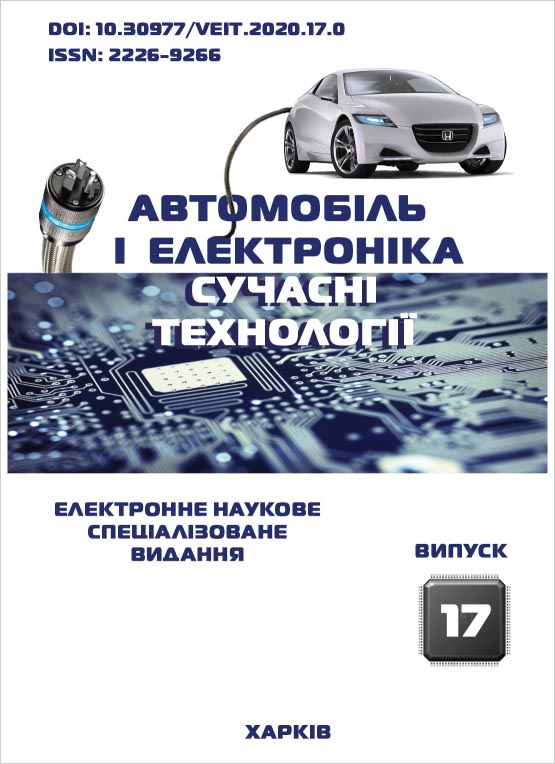Оцінка коефіцієнта корисної дії колісного рушія автомобіля
DOI:
https://doi.org/10.30977/VEIT.2022.21.0.08Ключові слова:
автомобіль, колісний рушій, енергоефективність, крутний момент, коефіцієнт корисної діїАнотація
Енергетична ефективність автомобіля є характеристикою раціонального використання потужності двигуна й витрачання запасів джерел енергії. На сьогоднішній день проблема оцінки коефіцієнта корисної дії колісного рушія автомобіля є однією з найбільш актуальних в сучасному машинобудуванні. Тому існує нагальна потреба в оптимізації здатності оцінки показників енергоефективності автомобіля шляхом отримання математичної моделі коефіцієнта корисної дії колісного рушія для подальшого раціонального проектування автомобілів по критеріям енергоефективності.
Посилання
Горелов В.А., & Чудаков О.И. (2017) Анализ конструктивных схем привода колес прицепных звеньев активных автопоездов. Известие МГТУ «МАМИ», (1), 16-24. Gorelov V., & Chudakov O.(2016).Analiz konstruktivnyih shem privoda koles pritsepnyih zvenev aktivnyih avtopoezdov.[Analysis of constructive schemes of wheel drive of trailer links of active road trains].Izvestie MGTU «MАMI», (1), 16-24. [In Russian].
Шухман С.Б., Соловьев В.И., & Прочко Е.И. (2007). Теория силового привода колес автомобилей высокой проходимости. Агробизнесцентр. Shuhman S.B., Solovev V.I., & Prochko E.I. (2007). Teoriya silovogo privoda koles avtomobiley vyisokoy prohodimosti.[Theory of the power drive of the wheels of off-road vehicles].Agrobiznestsentr. .[In Russian].
Можаєв, О.О. (2019) Мінімізація втрат потужності тягово-транспортних засобів при русі по опорній поверхні, яка деформується. Східноєвропейський журнал передових технологій, (97), 69–74. https://doi.org/10.15587/1729-4061.2019.156721. Mozhaev, O.O. (2019). Minimizatsiia vtrat potuzhnosti tiahovo-transportnykh zasobiv pry rusi po opornii poverkhni, yaka deformuietsia. [Minimization of power losses of traction vehicles when moving on the deformation bearing surface]. Skhidnoievropeiskyi zhurnal peredovykh tekhno-lohii, (97), 69–74. [In Ukrainian]
Гуськов, В.В. (2018). Динамическая характеристика многоцелевых колесных машин при движении по грунтовым поверхностям. БНТУ. Guskov, V.V. (2018). Dinamicheskaya harakteristika mnogotselevyih kolesnyih mashin pri dvizhenii po gruntovyim poverhnostyam. [Dynamic characteristics of multy-purpose wheeled machines during driving on ground surfase]. BNTY. [In Russian].
Кутьков, Г.М. (2016). Тракторы и автомобили: теория и технологические свойства. ИНФРА-М. Kutkov, G.M. (2016). Traktoryi i avtomobili: teoriya i tehnologicheskie svoystva.
[Tractors and cars: theory and technological properties].INFRA-M.
Абдулгазис, У. А., Клец, Д. М., & Подригало, М.А. (2010). Динамика колеса и устойчивость движения автомобиля. ДИАЙПИ. Abdulgazis, U., Klets, D., Podrihalo, M. (2010). Dinamika kolesa i ustoychivost dvizheniya avtomobilya. [Wheel dynamics and vehicle stability]. DIAYPI. [In Russian].
Лебедев, А.Т., Артемов, Н.Т., Подригало, М.А., & Кот, А.В. (2012). Радиус качения и оценка взаимодействия колеса автомобильной машины с дорогой. Технічні науки, 124 (2), 43-48. Lebedev, A., Artemov, N., Podrigalo, M.A., & Kot, A. (2012). Radius kacheniya i otsenka vzaimodeystviya kolesa avtomobilnoy mashinyi s dorogoy. [Rolling radius and assessment of the interaction of a car wheel with the road]. Tekhnichni nauky: Visnyk HNADU, 124 (2), 43-48. [In Russian].
Lihle, I., Dove, A., Mohlalakoma, T., & Otis, T. (2017). Heaviside based optimal control for ride comfort and actuation energy optimisation in half-car suspension systems. Modern mechanics, (2).259-264.
Абдулгазіс, А.У., Абрамов, Д.В., Артьомов, М.П., Подригало, М.А., & Полянський, О.С. (2019). Динаміка колеса автомобіля. ХНАДУ. Abdulhazis, A., V. Abramov, D., Artomov, M., Podryhalo, M., Polianskyi O. (2019). Dynamika kolesa avtomobilia. [Vehicle wheel dynamics]. HNADU. [In Ukrainian].
Подригало, М.А. (2007). Качение автомобильного колеса и определение понятия «тяговая сила» (В порядке обсуждения). Автомобильная промышленость, (1), 25-26. Podryhalo, M. (2007). Kachenie avtomobilnogo kolesa i opredelenie ponyatiya «tyagovaya sila» (V poryadke obsuzhdeniya). [Rolling of an automobile wheel and the definition of the concept of "tractive force" (By discussion)]. Avtomobilnaya promyishlenost, (1), 25-26. [In Russian].
Евсеев, П.П. (2006). Эффективный КПД движителя автомобиля. Автомобильная промышленность, (4), 12-14. Evseev, P. (2006). Effektivnyiy KPD dvizhitelya avtomobilya. [Efficiency of the vehicle propulsion]. Avtomobilnaya promyishlenost, (4), 12-14. [In Russian].
Kaidalov, R., Omelchenko, V. Podryhalo, M. (2021). Analisis of existing constructions of road trains with active trailers. Advances in mechanical engineering and transport, 2 (17), 11-16.
Пожидаев, С.П. (2014). К вопросу о радиусах эластичного колеса. Автомобильный транспорт, (4), 6-8. Pozhidaev, S. (2014). K voprosu o radiusah elastichnogo kolesa. [To the question of the radius of the elastic wheel].Avtomobilnyi transport, (4), 6-8. [In Russian].
Fangjie, Yu. (2016). Direct Energy Rebound Effect of Family Cars: An Analysis Based on a Survey in Chang-Zhu-Tan City Group. Energy Procedia, (104),197-202.
Петрушов, В.А. (2008). Автомобили и автопоезда:Новые технологии исследования сопротивления качению и воздуха. ТОРУС ПРЕСС. Petrushov, V. (2008). Avtomobili i avtopoezda:Novyie tehnologii issledovaniya soprotivleniya kacheniyu i vozduha. [Automobiles and road trains: New technologies for the study of rolling resistance and air]. TORUS PRESS. [In Russian].
Volvo Mean Green. (2015) The best-seeing hybrid vintage car in the world, (86), 12-14. Taken from http://interest.com/volvo-mean-green-the-fastest-automobile.
Travesset-Baro, О. (2016). Transport energy demand in Andorra. Assessing private car futures through sensitivity and scenario analysis. Energy Policy, (96). 78-92.
Fangjie, Yu. (2016). Direct Energy Rebound Effect of Family Cars: An Analysis Based on a Survey in Chang-Zhu-Tan City Group. Energy Procedia. (104), 197-202.
##submission.downloads##
Опубліковано
Як цитувати
Номер
Розділ
Ліцензія
Авторське право (c) 2022 Mykhailo Podryhalo, Ruslan Kaidalov, Vasyl Omelchenko

Ця робота ліцензується відповідно до Creative Commons Attribution 4.0 International License.
Автори, які публікуються у цьому журналі, погоджуються з наступними умовами:
1. Автори залишають за собою право на авторство своєї роботи та передають журналу право першої публікації цієї роботи на умовах ліцензії Creative Commons Attribution License, котра дозволяє іншим особам вільно розповсюджувати опубліковану роботу з обов'язковим посиланням на авторів оригінальної роботи та першу публікацію роботи у цьому журналі.
2. Автори мають право укладати самостійні додаткові угоди щодо неексклюзивного розповсюдження роботи у тому вигляді, в якому вона була опублікована цим журналом (наприклад, розміщувати роботу в електронному сховищі установи або публікувати у складі монографії), за умови збереження посилання на першу публікацію роботи у цьому журналі.
3. Політика журналу дозволяє і заохочує розміщення авторами в мережі Інтернет (наприклад, у сховищах установ або на особистих веб-сайтах) рукопису роботи, як до подання цього рукопису до редакції, так і під час його редакційного опрацювання, оскільки це сприяє виникненню продуктивної наукової дискусії та позитивно позначається на оперативності та динаміці цитування опублікованої роботи.





